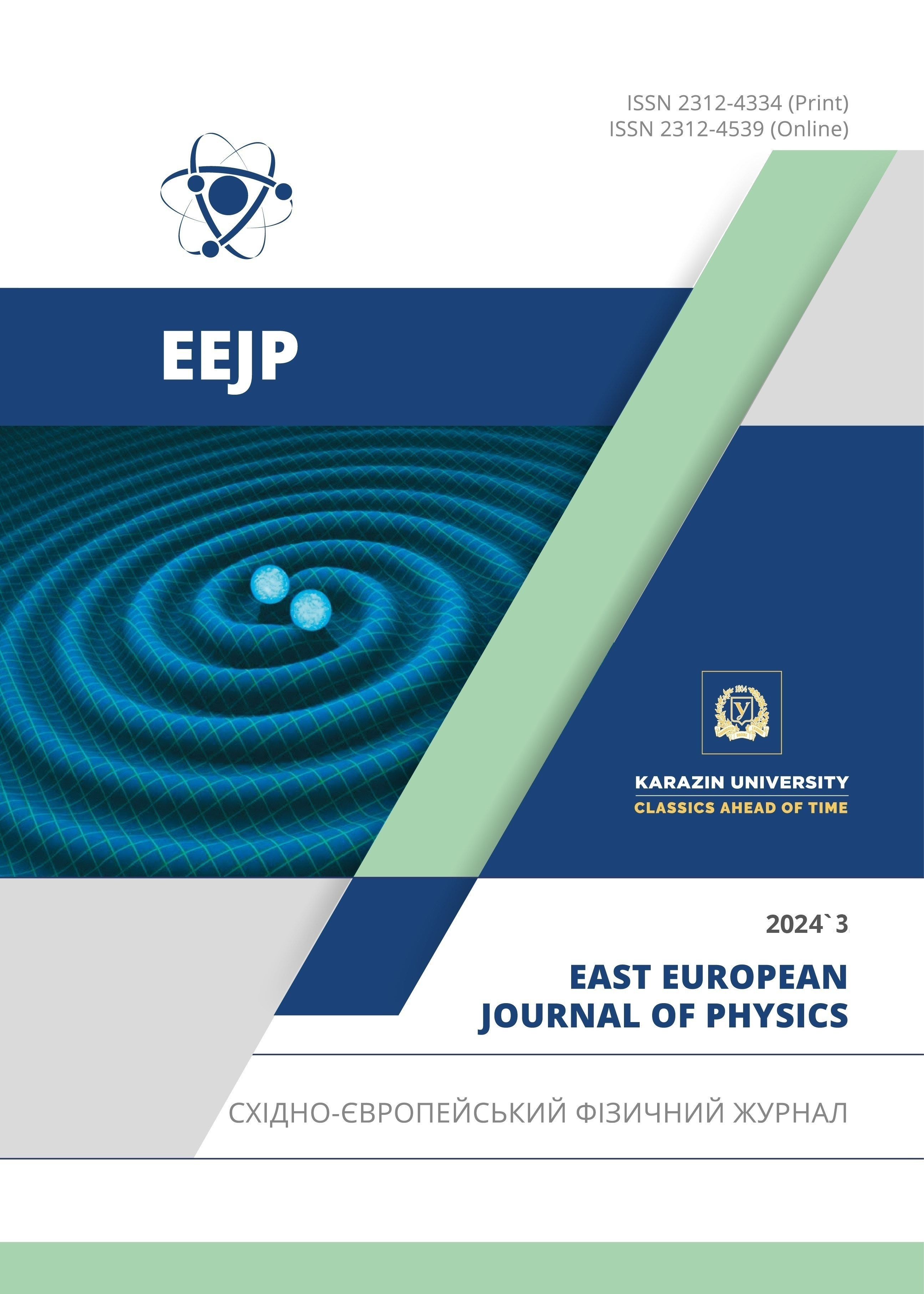Study on Anisotropic Dark Energy Cosmological Models in Generalized Brans-Dicke Theory
Abstract
In this present paper, we have investigated the dark energy cosmological model in Bianchi−V I0 spacetime by considering generalised Brans-Dicke theory, self-interacting potential, and a dynamical coupling parameter. For this purpose, we have utilised a hybrid scale factor to approximate the dynamical behaviour of the deceleration parameter. The deceleration parameter should display distinctive flipping behaviour at the transition redshift since the universe is thought to have changed from an early deceleration to a late temporal acceleration. We have studied six alternative transitioning dark energy models on the basis of observational restrictions on the transition redshift. For each model, the behaviour of the dynamical scalar
field, the Brans-Dicke parameter, and the self-interacting potential are examined. On top of that, we used the generalised Brans-Dicke theory to estimate how the Newtonian gravitational constant changes over time.
Downloads
References
A.G. Riess, et al., Astron J. 116, 1009 (1998). https://doi.org/10.1086/300499
S. Perlmutter, et al., Nature, 391, 51 (1998). https://doi.org/10.1038/34124
C.L. Bennett, et al., Astrophys. J. suppl. 148, 1 (2003). https://doi.org/10.1086/377253
D.N. Spergel, et al., Astrophys. J. Suppl. 148, 175 (2003). https://doi.org/10.1086/377226
S.M. Carroll, et al., Living. Rev. Relativ. 4, 1 (2001). https://doi.org/10.12942/lrr-2001-1
T. Padmanabhan, Phys. Rep. 380, 235 (2003). https://doi.org/10.1016/S0370-1573(03)00120-0
C.H. Brans, and R.H. Dicke, Phys. Rev. 124, 925 (1961). https://doi.org/10.1103/PhysRev.124.925
C.M. Will, Theory and Experiment in Gravitational Physics, (Cambridge University, Cambridge, (1981).
C. Mathiazhagan and V.B. Johri, Class. Quantum Grav. 1, L29 (1984). https://doi.org/10.1088/0264-9381/1/2/005
D. La, and P.J. Steinhardt, Phys. Rev. Lett, 62, 376 (1989). https://doi.org/10.1103/PhysRevLett.62.376
N. Banerjee and D. Pavon, Class. Quant. Grav., 18, 593 (2001).
S. Sen and A.A. Sen, Phys. Rev. D, 63, 124006 (2001).
D.F. Mota and J.D. Barrow, Mon. Not. R. Astron. Soc. 349, 291 (2004).
D.F. Mota and J.D. Barrow, Phys. Lett. B, 581, 141 (2004).
S. Das and N. Banerjee, Phys. Rev. D, 78, 043512 (2008).
N. Banerjee and D. Pavon, Phys. Rev. D, 63, 043504 (2001). https://doi.org/10.1103/PhysRevD.63.043504
K. Nordtvedt (Jr), Astrophys. J. 161, 1059 (1970). https://doi.org/10.1086/150607
J.P. Mimoso and A.M. Nunes, Phys. Lett A, 248, 325 (1998). https://doi.org/10.1016/S0375-9601(98)00724-5
M.V. Santhi, et al., Canadian Journal of Physics, 95(2), 179 (2017). https://doi.org/10.1139/cjp-2016-0628
E.A. Hegazy, and F. Rahaman, Indian Journal of Physics, 94(11), 1847 (2020). https://doi.org/10.1007/s12648-019-01614-4
Y. Aditya, et al., Indian Journal of Physics, 95, 383 (2021). https://doi.org/10.1007/s12648-020-01722-6
D. Chhajed, et al., Journal of Ultra Scientist of Physical Sciences-Section A. (Mathematics), 34(4), (2022). http://dx.doi.org/10.
/jusps-B/340401
S.K. Tripathy, et al., Physics of the Dark Universe 30, 100722 (2020). https://doi.org/10.1016/j.dark.2020.100722
S.K. Tripathy, et al., The European Physical Journal C, 75, 149 (2015). https://doi.org/10.1140/epjc/s10052-015-3371-3
C.B. Collins, et al., Gen. Relativ. Gravit. 12, 805, (1980). https://doi.org/10.1007/BF00763057
S. Capozziello, et al., Phys. Rev. D, 73, 043512 (2006), https://doi.org/10.1103/PhysRevD.73.043512
E. Babichev, et al., Clas. Quant. Grav. 22, 143 (2005). https://doi.org/10.1088/0264-9381/22/1/010
S.K. Tripathy, et al., Physics of the Dark Universe, 30, 100722 (2020). https://doi.org/10.1016/j.dark.2020.100722
R.R. Caldwell, Phys. Lett. B, 545, 23 (2002). https://doi.org/10.1016/S0370-2693(02)02589-3
E.V. Linder, Phys. Rev. Lett. 90, 091301 (2003). https://doi.org/10.1103/PhysRevLett.90.091301
B. Mishra and S.K. Tripathy, Mod. Phys. Lett. A, 30, 1550175 (2015). https://doi.org/10.1142/S0217732315501758
B. Mishra, et al., Mod. Phys. Lett. A, 33, 1850052 (2018). https://doi.org/10.1142/S0217732318500529
B. Mishra, et al., Astrophys. Space Sci. 363, 86 (2018). https://doi.org/10.1007/s10509-018-3313-2
Study on Anisotropic Dark Energy Cosmological Models in Generalized Brans-Dicke Theory
EEJP. 3 (2024)
P.P. Ray, et al., Int. J. Mod. Phys. D, 28, 1950093 (2019). https://doi.org/10.1142/S0218271819500937
B. Mishra, et al., Mod. Phys. Lett. A, 34, 1950217 (2019). https://doi.org/10.1142/S0217732319502171
B. Mishra, et al., Journal of Astrophysics and Astronomy, 42, 2 (2021). https://doi.org/10.1007/s12036-020-09655-6
N.G. Busca, Astron. Astrophys. 552, A96 (2013). https://doi.org/10.1051/0004-6361/201220724
S. Capozziello, et al., (2014). https://doi.org/10.48550/arXiv.1403.1421
A.G. Reiss, et al., Astrophys. J. 659, 98 (2007). https://doi.org/10.1086/510378
J. Lu, et al., Phys. Lett. B, 699, 246 (2011). https://doi.org/10.1016/j.physletb.2011.04.022
M. Moresco, et al., (2016). https://doi.org/10.48550/arXiv.1601.01701
Copyright (c) 2024 M. Vijaya Santhi, K. SantoshRupa

This work is licensed under a Creative Commons Attribution 4.0 International License.
Authors who publish with this journal agree to the following terms:
- Authors retain copyright and grant the journal right of first publication with the work simultaneously licensed under a Creative Commons Attribution License that allows others to share the work with an acknowledgment of the work's authorship and initial publication in this journal.
- Authors are able to enter into separate, additional contractual arrangements for the non-exclusive distribution of the journal's published version of the work (e.g., post it to an institutional repository or publish it in a book), with an acknowledgment of its initial publication in this journal.
- Authors are permitted and encouraged to post their work online (e.g., in institutional repositories or on their website) prior to and during the submission process, as it can lead to productive exchanges, as well as earlier and greater citation of published work (See The Effect of Open Access).








